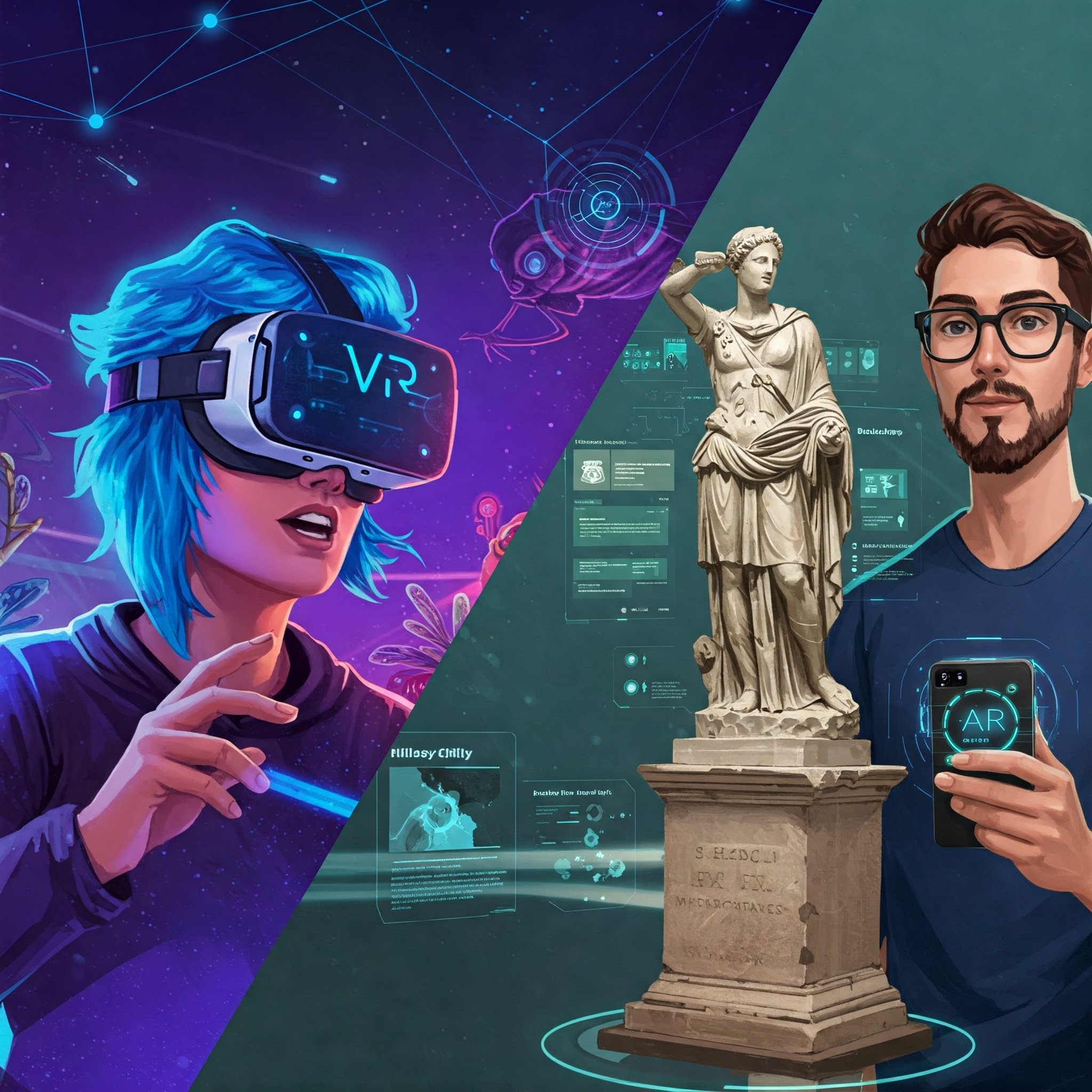Understanding VR/AR: What's Next for Immersive Technologies?
The lines between our physical and digital worlds are blurring, thanks to the rapid advancements in immersive technologies like Virtual Reality (VR) and Augmented Reality (AR). These aren't just concepts from science fiction anymore; they are actively transforming industries and our daily experiences. This guide offers a clear virtual reality explained section, explores diverse augmented reality applications, peeks into the future of VR gaming, sees how AR in retail is changing shopping, and highlights key immersive tech trends for 2025 and beyond. We'll also look at how innovative platforms are starting to integrate these technologies in unique ways.
Virtual Reality (VR) Explained: Stepping into New Worlds
Virtual Reality (VR) is a technology that creates a completely simulated, three-dimensional environment that users can interact with in a seemingly real way. Typically, this involves wearing a VR headset that covers the eyes, blocking out the physical world and replacing it with computer-generated imagery and sound.
- How it Works: VR headsets use high-resolution screens (one for each eye) and specialized lenses to create a stereoscopic 3D effect. Head tracking sensors within the headset detect your movements, allowing the virtual environment to shift and respond as you look around. Handheld controllers often accompany headsets, enabling you to interact with virtual objects and navigate the digital space.
- Immersion is Key: The goal of VR is full immersion, making you feel truly present in the virtual environment. This is achieved through a combination of realistic visuals, spatial audio (sound that appears to come from specific directions), and sometimes even haptic feedback (sensations of touch or motion).
- Types of VR:
- Standalone VR: Headsets like the Meta Quest series have all the processing power built in.
- Tethered VR: Headsets that connect to a powerful PC or gaming console for more demanding experiences.
Augmented Reality (AR) Applications: Enhancing Our Reality
Unlike VR, which replaces your surroundings, Augmented Reality (AR) overlays digital information, graphics, or objects onto your view of the real world. This is usually experienced through smartphone screens, tablets, or increasingly, specialized AR glasses.
Augmented reality applications are incredibly diverse and growing rapidly:
- Gaming: Pokémon GO is a classic example, bringing digital creatures into real-world locations.
- Retail (AR in Retail): This is a huge area of growth.
- Virtual Try-Ons: See how clothes or makeup would look on you without physically trying them on. Adidas has experimented with virtual shoe try-ons, and beauty brands offer AR filters for testing cosmetics.
- Furniture Visualization: Apps like IKEA Place allow you to virtually place 3D models of furniture in your own home to see how they fit and look.
- Interactive Product Information: Point your phone at a product to get reviews, tutorials, or usage instructions.
- In-Store Navigation & Experiences: Some retailers are using AR for in-store navigation in large malls or to create engaging scavenger hunts and interactive displays. Home Depot, for instance, has used AR to help customers visualize paint colors on their walls.
- Education: AR can bring textbooks to life with interactive 3D models, create immersive historical reconstructions, or provide hands-on training simulations.
- Healthcare: Surgeons can use AR for overlaying patient data during operations, and it's used in medical training for realistic simulations.
- Navigation: AR can overlay directions onto your live view of the street.
- Manufacturing and Maintenance: Technicians can get AR-guided instructions overlaid on complex machinery.
- Marketing and Advertising: Interactive AR ads and experiences that allow consumers to engage with brands in new ways. Netflix has used AR for promotional experiences for shows like Stranger Things.
The Future is Immersive: Key Tech Trends
Immersive tech trends point towards even more seamless and integrated experiences:
- AI Integration: Artificial Intelligence is dramatically enhancing VR and AR. AI can personalize experiences in real-time, create more realistic and responsive virtual characters (NPCs), and even assist in the creation of immersive content itself.
- Improved Hardware: Headsets are becoming lighter, more comfortable, with higher resolutions, wider fields of view, and better tracking. Smart glasses are also evolving to make AR more accessible in daily life.
- 5G and Cloud Streaming: The rollout of 5G networks and advancements in cloud technology are reducing the need for powerful local hardware, enabling high-fidelity VR/AR experiences to be streamed to lighter devices.
- Haptic Feedback Advancements: Technology that allows you to "feel" virtual objects is becoming more sophisticated, adding another layer of immersion.
- The Metaverse Concept: While still evolving, the idea of interconnected, persistent virtual worlds where users can socialize, work, play, and learn is a major driver for VR/AR development.
- Spatial Computing: This involves how humans and machines interact in 3D space, blending digital and physical realities more intuitively.
VR Gaming's Next Level
The future of VR gaming is particularly exciting:
- Hyper-Realistic Environments: Expect even more visually stunning and detailed game worlds.
- AI-Powered Gameplay: More intelligent NPCs, adaptive storylines, and dynamic game environments that react to player actions.
- Social VR Platforms: More streamlined and feature-rich platforms for social interaction, attending virtual events (concerts, parties), and collaborative gaming.
- Cross-Platform Integration: Games that can be played across different VR (and even non-VR) platforms.
- VR Esports: The competitive VR gaming scene is growing.
- Full-Body Tracking & Advanced Haptics: More immersive physical interaction within games.
Spotlight on Innovative AR Experiences: Play, Learn, Earn & Explore
Beyond mainstream applications, companies are creatively leveraging AR to offer unique user engagement:
- Baakhapaa App – Play, Learn, Earn with an AR Twist: While Baakhapaa App primarily positions itself as an infotainment and storytelling platform where users "Play, Learn, and Earn" through video content and challenges, the potential for AR integration is significant. Their model of earning points and leveling up to become a creator could be enhanced with AR quests and challenges. Imagine users participating in location-based AR challenges tied to stories, or creators using AR tools to build more immersive narratives. The "infotainment" aspect could evolve to include AR educational experiences, where learning about culture or history involves interacting with 3D AR models or scenes triggered by real-world cues. As users progress and earn badges, these could unlock exclusive AR content or creator tools.
- HillyChilly – Augmented Adventures for Travellers: The travel industry is ripe for AR innovation. While specific AR quest details for HillyChilly.com require deeper investigation into their app's functionalities, platforms like it can greatly benefit from AR. Imagine using the HillyChilly platform where travelers embark on an AR quest through a city or natural landscape. Historical sites could come alive with AR overlays showing past events, or nature trails could feature AR information about flora and fauna. Gamified AR challenges could guide tourists to hidden gems, offer interactive puzzles at landmarks, or provide a more engaging way to learn about local culture, transforming a standard trip into an immersive adventure.
The Ever-Evolving Immersive Landscape
Virtual and Augmented Reality are more than just novelties. They represent a fundamental shift in how we interact with information, entertainment, and each other. From transforming how we shop and learn to offering new frontiers in gaming and travel, VR and AR are set to become even more integrated into our lives. As the technology becomes more accessible, powerful, and intuitive, the possibilities for immersive experiences are truly limitless.
Feeling immersed in knowledge? Head over to our website after reading this guide to play our "Immersive Tech Expert" quiz and earn points while testing your understanding of VR and AR!
Please login to leave a comment.


 Rakesh Rajbhat
Rakesh Rajbhat




